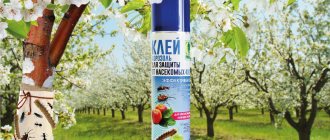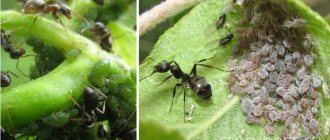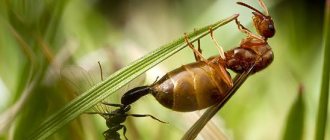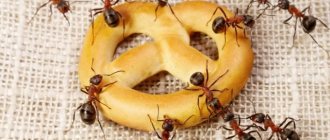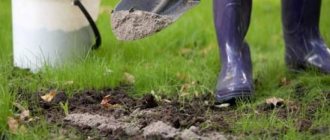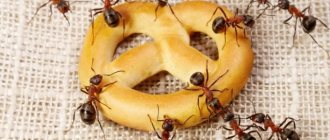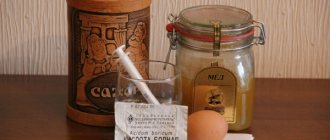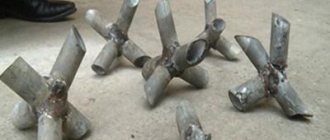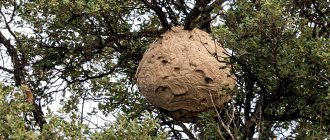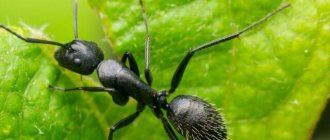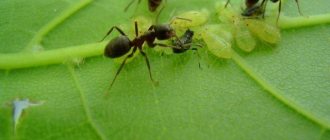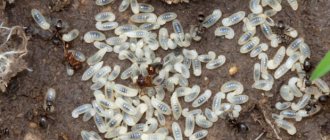If you want to protect your apple, pear or cherry tree from moths, leaf rollers, weevils and ants, you should use a trapping belt. These simple and effective traps will help get rid of uninvited guests once and for all.
Hot summers contribute to the appearance of a large number of pests. Fruit trees are especially affected by this. Most insects and other parasites climb the trunks to the most delicious parts of the trees - leaves, flowers, and subsequently to the fruits. Is it possible to stop pests at the stage of “marching” to the crown of the tree? Yes, especially if you use such a simple tool as a hunting belt.
Types of hunting belts
Ant traps in the form of catching belts are devices that are widely used for mechanical control of garden pests. In most cases, they look like a strip 20–25 cm wide. Rubber, burlap, plastic film, straw, rags, paper or cardboard are used to make them. Today, sticky, poisonous, dry hunting belts are used. The latter are the most popular. More details about the types:
- Funnel belt. A simple but effective design that looks similar to a funnel with a “pull-in effect.” In other words, insects crawl inside the trap and cannot get out.
- Double-sided funnel. A universal version of an ant trap that prevents both insects crawling up and sliding down.
- Belt-collar. The second most popular and widespread version of the catching belt. This device is not intended for insects that rise upward, but for those that descend to the ground to pupate or overwinter in the ground.
- Poisonous hunting belt. Many gardeners are afraid of the word “poisonous”, because... they believe that the poison will get on the fruits of the tree and they will no longer be consumed. In fact, this statement is incorrect, because The ant trap must be attached at the foot of the trunk. Thanks to this, chemicals will not penetrate the root system and will not flow up to the crown.
- Sticky hunting belt. This version of the device is widely used in combination with other devices, but sometimes it is fixed separately - in this case, the sticky trap also copes well with pests. It catches ants, beetles and caterpillars very well.
- 7 Everyday Habits That Are Bad for Your Joints
- Protein cream recipe
- Fungus on the palms
Advantages and disadvantages
Ant hunting belts on fruit trees are especially effective against those insects that first descend to the ground to pupate and then climb up the tree trunk in search of food. Such pests are geese, beetles, aphids, caterpillars, weevils and some others. The catching belt has several obvious advantages over alternative means:
- such a trap is environmentally friendly, absolutely safe for humans and trees;
- helps rid the tree of most insects, because they cannot get around it and therefore inevitably fall into a trap;
- You can purchase a ready-made version of the device or make it yourself.
As for the shortcomings, there are almost none. True, insects from the useful category often fall into the hunting belt:
- bees;
- bumblebees;
- ladybugs and others.
Dry
Dry belts are the most popular, valued for their environmental friendliness and ease of DIY creation.
This type of construction is usually made from matting, burlap, and corrugated paper. Before applying the finished strip, you should rid the trunk of the old bark and cover up the cracks. A belt with a thickness of at least 20 cm is strengthened with twine, but be sure to leave free edges. Next, we will tell you in more detail what a dry belt looks like in the form of a funnel, a gate and a double-sided funnel.
Funnel
The design received its name not only for its external similarity, but also for its ability to draw pests into the very middle of the device. To make a funnel, you will need a thick sheet of paper or cardboard, which you need to wrap the barrel in a circle. This is how you create a cone. There should be a gap between the bottom of the leaf and the surface of the trunk. While the top of the paper must come close to the bark. Fastening is usually done with twine or a rope. It is recommended to coat those places through which insects can still penetrate with clay.
Gate
Another type of catching belt is called a collar. A sheet should be cut from rubber, the thickness of which will be about 4 mm. They need to wrap the apple tree so that the end result is a trap with curved edges. The ends of this strip must be fastened using special rubber glue. The completed gate needs to be filled with sunflower oil. Experienced gardeners often add a decoction they make from the foliage of a tree, on which a protective device is hung. You will need to add oil from time to time, remove pests from the strip, and also change the gate to a larger one as the apple tree grows.
Double-sided funnel
In addition to the usual funnel, some craftsmen make protective strips, which are commonly called double-sided funnels. You should wrap the crop trunk with a strip of thick paper or cardboard, the width of which will be about 30 cm. This structure is attached in the middle, leaving the upper and lower parts hanging freely. And don’t forget to cover all the places through which pests can penetrate with clay.
How to make an ant trap with your own hands
To make a dry belt, you will need to take a strip (rubber, corrugated paper or coarse fabric) about 20 cm wide. The length of the product will depend on the thickness of the fruit tree. Before you begin tying, seal all existing cracks. When making a dry ant hunting belt, you should consider the following:
- It is recommended to use stretch film for wrapping, especially if the wind is blowing. Unlike tape, it will not stick to the surface.
- Corrugated cardboard is best for use in the fall. This way you can protect the fruit tree from pests looking for a secluded place to settle down for the winter or lay offspring.
- It is recommended not to use cardboard on warm days.
To make a dry insect trap belt, you will need foam rubber, stretch film, scissors and a knife. How to properly wrap a fruit tree:
- To begin, prepare the foam rubber by measuring the material with a certain margin so that the edges can be joined to the trunk not butt-to-butt.
- Wrap the foam several times using stretch film. Two or three turns should be enough.
- Take a roll of film and wrap the foam rubber not too tightly. This is necessary in order to remove the gap at the junction of the edges. Make three or four turns.
- The tape must be cut and carefully smoothed to the belt. After this, use a sharp knife to remove the excess part above the belt in the lower and upper parts. This way the tree will look more neat, and the bark will be freed from excess insulation.
- Check the trap on each fruit tree about once a week. In order not to upset the balance, carefully remove the belt and scatter beneficial insects onto the newspaper, then wait until they crawl away on their own.
- 4 reasons to take a bath, how to do it right
- 16 Brain Foods That Keep Your Mind Clear As You Get Old
- How to treat Coxsackie virus
Natural enemies
If we talk about natural conditions, then in the forest hedgehogs, frogs, lizards and other animals are not averse to feasting on goosebumps. It will not be possible to create such a zoo in vegetable gardens and orchards, and they will do more harm than good. Therefore, you have to rely on nature and luck, which will attract natural pest exterminators without damaging the garden.
Birds are not averse to eating goosebumps, they especially love larvae and will not bypass the queen. During the day you can often see a picture of a bird raking the soil and diligently looking for something; it is looking for these particular pests.
But you can’t count on their help, because with large concentrations of pests, more than one bird is needed, and the process of destroying anthills takes time, and we all know that birds don’t like to be neighbors with people, so their help will be minimal.
An antlion can be an ideal savior; this beetle is the most dangerous for pests and is capable of completely clearing an area of ants and other pests. If there is an opportunity to settle it on your site, this opportunity should not be missed.
Funnel belt
To make the simplest version of an ant trap, you will need smooth paper or cardboard. Insects will crawl into the resulting funnel, but they will not be able to get out. This is the effectiveness of using such a protective device. It's not that difficult to do:
- Prepare material 15–20 cm thick and wrap it around the trunk at a height of approximately 50–60 cm. As a result, you should end up with a cone-like skirt or funnel, inverted with a narrow opening up.
- The “entrance” hole, which is intended for ants and other insects, will be wide. The trap must end in a dead end.”
- The top of the funnel will need to be tied tightly with rope or twine. An alternative option is smearing using plasticine or clay.
Safe chemistry in the garden
Today the word chemistry is treated with caution. But not all means are dangerous. In the garden, you can use time-tested methods that do not harm not only humans, but also plants. So, an indispensable assistant for a gardener is lime. It is used to whiten trunks, and you can also add it to the tree trunk circle. It is poisonous to ants. And although the colony will not die from such a remedy, insects will avoid the treated area. No less popular and useful in the garden is boric acid. It is used for cosmetic and medical purposes. This is an excellent antiseptic. But for insects it is a strong poison that acts both superficially and through the intestines. In the garden, it can simply be added to the soil in powder form. If you need to get rid of an anthill, then remove a layer of soil from it and pour poison directly into the center of the nest.
Prices for chemicals against ants
Ants often settle on young trees. Boric acid will also tell you how to get rid of them. It is diluted in warm water. The solution is sprayed on the tree. It affects not only ants, but also aphids. Moreover, it is completely safe not only for the plant, but also for people. The harvest from sprayed trees can be eaten even on the day of treatment.
This is how you can use borax. It is no less toxic to insects than boric acid and their effect is similar. It is added to baits. In stores you can buy granular Anti-Ant preparation, which contains 10% borax. The granules can be left in blisters in places where insects are located or poured into the anthill itself.
To protect plants in the garden, you can dilute the drug in water and use it for spraying. The product is completely safe for people and animals, even if swallowed. The powder decomposes quickly and does not affect the eggs and larvae of insects, so to obtain a positive result you will need several treatments with a break of two weeks. This product is less effective than modern pesticides, but it is great for households that try not to use chemicals.
OUR READERS RECOMMEND!
Gate trap for ants
Making a collar belt is as easy as making a funnel. The trap remains almost invisible on the trunk and, moreover, it is able to “transform” along with the tree. How to make an ant trap in the form of a collar - detailed instructions:
- Cut a rubber tape 4-5 mm thick and measure about half a meter from the ground level.
- Bend the edges and secure the tape to the trunk - you will get a kind of “collar”. Then glue the ends of the strip together with glue.
- Add sunflower oil to the resulting sealed container. Pests that get into the container will not be able to get out of it and continue moving down.
- The resulting elastic trap against ants and other insects will grow along with the tree. It can last a long time, the most important thing is to promptly remove any bugs that get into it and add vegetable oil.
What is it used for?
If the apple tree does not have such a belt, it is easy for pests to get to the young and tender leaves, flowers and fruits along the branches, because all this is excellent food for them. Throughout the growing season of the apple tree, there is more than enough of this delicacy for them. Unfortunately, this is not greed, but a common fact - such insects are very harmful to the trees, and the consequences can be irreversible: the harvest falls, the beauty begins to wither and get sick. When autumn comes, insects descend from the apple tree and return to their traditional habitats.
What's all this for? Moreover, it is in spring and autumn that apple trees can be effectively protected with the help of catching belts. During this period they are most effective. In spring, they prevent insects from penetrating the bark and thicket of the crown, which helps protect flowers and leaf buds. In summer, it serves as a trap for caterpillars, which head to the tree in which they pupate. A self-made catching belt can destroy up to 40 percent of all pests in a season. Of course, it is not effective in all cases. For example, the codling moth begins to fly in August, at which time there is practically nothing you can do with it, but if you use a belt, you can catch many caterpillars in advance and reduce the number of butterflies.
Poison Hunter Belt
This version of the belt can guarantee almost 100% efficiency, i.e. pests crawling inside cannot find a way out and die from toxic fumes. Very often, a poisonous hunting belt is hung on apple trees - this way it can effectively prevent the movement of caterpillars and other insects upward to the fruits. A suitable insecticide is used as poison. You can make a similar trap like this:
- Take a piece of burlap, paper or other suitable dense material 20 to 25 cm wide.
- Soak the material in an insecticide solution, then secure it to a tree trunk at a height of 40–50 cm from the surface of the ground so as to form a “skirt”;
- The upper part of the resulting ant trap must be wrapped in film, otherwise the poison will begin to erode.
Ants on an apple tree: harm or benefit?
Ants are the orderlies of the forest; they play an important role and bring many benefits. But their appearance in garden plots often becomes a big problem, regardless of the site they have chosen.
Ants on an apple tree can cause the death of young, immature trees, and their active activity can completely deprive the harvest.
Ants on an apple tree: benefits from red ants and harm from black ants:
If even the slightest presence of these insects is detected, you must act immediately. In this case, the age of the plant does not matter. The active activity of ants can destroy the crop, and the entire apple tree after some time.
Ants are the harbingers of aphids, which quickly colonize affected trees. The insects themselves do not harm the trunk of the apple tree and leaves, but they destroy young buds and apples. They suck the juices from the apple tree and fruits, and eat the remains of aphids. Therefore, their task is to attract a large number of aphids, stock up on their larvae for the winter, and drag them onto the plant again so that the aphids can reproduce.
As soon as a large-scale colonization of ants on a tree has been noticed, you can expect an invasion of aphids within a couple or three weeks, and this will already destroy the entire crop.
Sticky Ant Belt
Making such a trap requires some skill and accuracy. You will have to work with glue that takes a long time to dry. Below you can learn how to make a trapping belt for this type of ants yourself:
- To begin, you need to cut a piece of craft paper 20 to 25 cm wide - it should cover the circumference of the tree trunk.
- Then coat one side of the trap with special non-drying glue, tar or resin.
- Attach the resulting device to the trunk with the adhesive side up.
- Seal possible “passages” both below and above the adhesive belt.
How to prepare a tree trunk
Before we start making the hunting belt, we will properly prepare the tree trunk for this event.
Attention! Preparing the base of the tree for installation of a catching belt is an action on which the effectiveness of the entire ant control activity directly depends.
Preparing a tree trunk for setting a trap requires compliance with one important rule. At the installation site of the belt, it is necessary to carefully cover all cracks in the bark, especially when processing old plantings. The following can be used as a putty material:
- clay + sawdust;
- plasticine, etc.
If you do not follow this rule, then insects will easily bypass the installed barriers through cracks, and all pest control measures taken will be useless.
Tips and recommendations for use
After learning how to make an ant trap, check out several useful tips for using it. More details about them:
- The hunting belt should be placed on the tree trunk at a height of 30 to 60 cm from the base. It should be strictly below the crown. In the area where you plan to install the trap belt, the non-living bark will need to be removed.
- Cracks formed in the living bark must be covered with clay. If you miss this nuance, then at the end of the summer period insects can lay offspring or settle down for the night.
- Inspect and get rid of pests that are stuck in the trap belt. This must be done every day, otherwise some part may escape from the trap.
- It is recommended to fasten the ant trap belt before the buds awaken, so that insect pests that winter in the ground do not have time to get out and crawl into the crown.
- Remove trapping belts from stone fruit trees after harvesting, but it is better to leave them on pear and apple trees until the end of October. This approach helps fight the winter moth, which lays eggs and goes underground to spend the winter.
- Replace trap belts after they become full of insects and as needed. Carefully ensure that no passages appear in them, which open the way for small parasites to food and crown.
- When the flower beetle’s “run” begins, inspect the traps as often as possible. Knock down the pests that get into them onto the film, which you first lay on the ground under the tree.
- Before winter begins, remove the belts from the trees and then burn them.
Prevention measures
To prevent pest control from causing much trouble, it is better to prevent the appearance of pests in your garden.
To do this, damaged bark is removed from trees in spring and autumn. Places with disturbed cover are treated with lime. Do not overdry the soil. It needs to be mulched. Clear the space under the plum tree from grass. Do not plant viburnum or linden next to fruit trees. Aphids especially love these plants. And the ants will easily deliver it to the plum, apple, and cherry trees located nearby. It is better to sow parsley, parsnips or other aromatic herbs here, which are suitable neighbors for fruit trees.
Before buds appear, plants are often treated with an aqueous solution of diesel fuel. Deformed leaves are torn off and destroyed. The first pests noticed are destroyed by knocking them off the plants with water pressure from a hose.
Look after the garden, destroy all pests in a timely manner. Take fruit trees under your protection. They will delight you more than once with ripe plums, plump apples and red-sided apricots.
